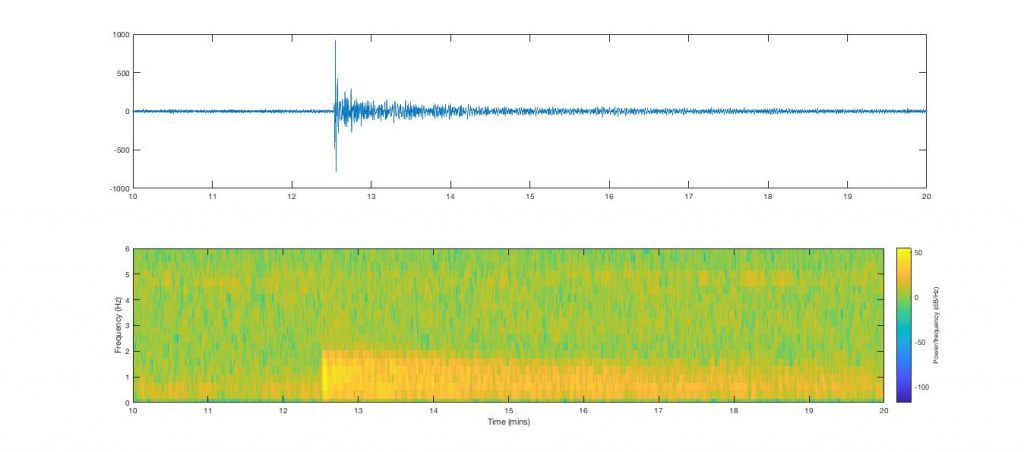On Sept. 3 at Wupatki National Monument, just north of Flagstaff, the WUAZ seismometer picked up vibrations, eventually measuring a magnitude 6.2 disturbance to the Earth’s crust.
That disturbance was not an earthquake. It was North Korea testing a nuclear weapon 6,000 miles away.
Ryan Porter, a geophysicist and assistant professor of geology at Northern Arizona University, uses data from the WUAZ and other seismometers to monitor seismic activity throughout the globe. Although that is usually earthquakes, such as the swarm in southeastern Idaho in early September and the 8.0M earthquake that struck 70 kilometers below Mexico on Sept. 8, the equipment is sensitive enough to pick up nuclear tests anywhere in the world. Porter talked to NAU News about the similarities and differences in measuring earthquakes versus nuclear activity, how quickly the world knew the Sept. 3 event was a nuclear test and how the Cold War contributed to the study of earthquakes.
What is the relationship between earthquakes and nuclear testing?
The reason the seismology equipment exists the way it does is because of nuclear testing. In the 1950s and 1960s, once governments started testing these weapons on the ground, scientists couldn’t readily detect the size of those tests by looking. They needed other ways to detect how large these weapons were, so they turned to seismometers, fine-tuning these instruments to make them increasingly able to pick up signals. It turns out, when you explode a nuclear weapon, it causes a seismic signal, that is a bunch of vibrations beneath the Earth’s surface, which the equipment can measure and record.
As nuclear nonproliferation treaties went into effect, scientists started using seismic arrays to measure earthquakes, which produce similar seismic signals. In a way, earthquake detection is almost a side effect of that nuclear activity. It was the impetus to build global seismic networks.
How does a nuclear test present differently than an earthquake?
With a typical earthquake, there’s motion along a fault. Because of that, the Earth compresses in some places and dilates, or expands, in other places. You take the seismic waves from all around a certain earthquake and look at them—if they go up, that indicates compression; if they go down, that indicates dilation.
If we have any kind of explosion, all we see is compression for the first motion. If the very first energy goes up, that indicates compression in all directions.
What role does seismology play in understanding and measuring nuclear tests?
First, it’s detection. We wouldn’t have known that test was happening without seismology. There are other ways, but the first, best indication someone had a test was due to seismology. Scientists knew within about two minutes what had happened. So it’s a good way to determine if a test happened.
Also, the subtleties of seismic waves allow us to measure size. This was a magnitude 6.2, which is a logarithmic function of how much energy is released in a nuclear test. One of the ways we know North Korea’s nuclear programs are growing more sophisticated is the seismic signals are getting larger.
(For reference, the 1995 Oklahoma City bombing registered as about magnitude 3, and the explosion from the atomic bomb the U.S. dropped on Hiroshima was just more than magnitude 6.)
Then people can really look at the subtleties of seismic waves and determine how the explosion occurred—if it’s one big explosion or if there were secondary signals. This one could have included a tunnel collapse.
What sorts of events are large enough that a seismometer could sense it?
Five or six years ago there was a big debris flow in a mine in Utah, and people picked it up with seismic data. It’s anything that causes a vibration. Anything that’s big, we can detect. It’s also a function of how close seismometers are. If we had a seismometer on the NAU campus it could pick up cars driving by. We don’t, because that’s just white noise; we’re interested in the bigger events.
With North Korea’s nuclear testing, the seismometer isn’t reacting to the nuclear bomb, but the bomb itself. If you exploded a bunch of dynamite we could pick that up. It’s the amount of energy released that excluded to a nuclear explosion. It would take several tons to several thousand tons of dynamite to release that much energy.



